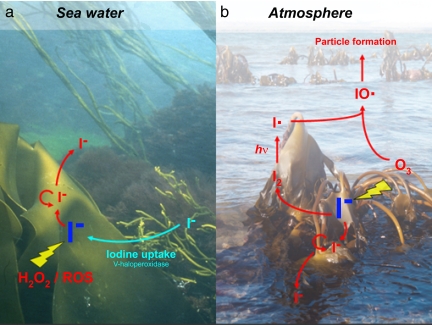Fig. 4.
A model of iodine metabolism in Laminaria. Laminaria, when submerged and unstressed (a), accumulates iodide from seawater mediated by vanadium haloperoxidase (turquoise). In the tissues and as shown in this study, I− is the accumulated form. When oxidative stress occurs (red), iodide is released to detoxify ROS in the apoplast at the thallus surface outside of the cell membrane, including both aqueous (e.g., H2O2) and gaseous (O3) oxidants. ROS scavenging reactions in the aqueous phase such as halide-assisted disproportionation of H2O2 will result in the regeneration of iodide in a cyclic reaction sequence. (a) During oxidative stress at high tide (e.g., due to an oxidative burst caused by alginate-degrading bacteria in a biofilm), iodide is released into the surrounding seawater. (b) In contrast, aerosol particle bursts result mainly from molecular iodine released directly from Laminaria into the coastal atmosphere, as a consequence of the ozone-scavenging reactivity of iodide on kelp surfaces at low tide.

